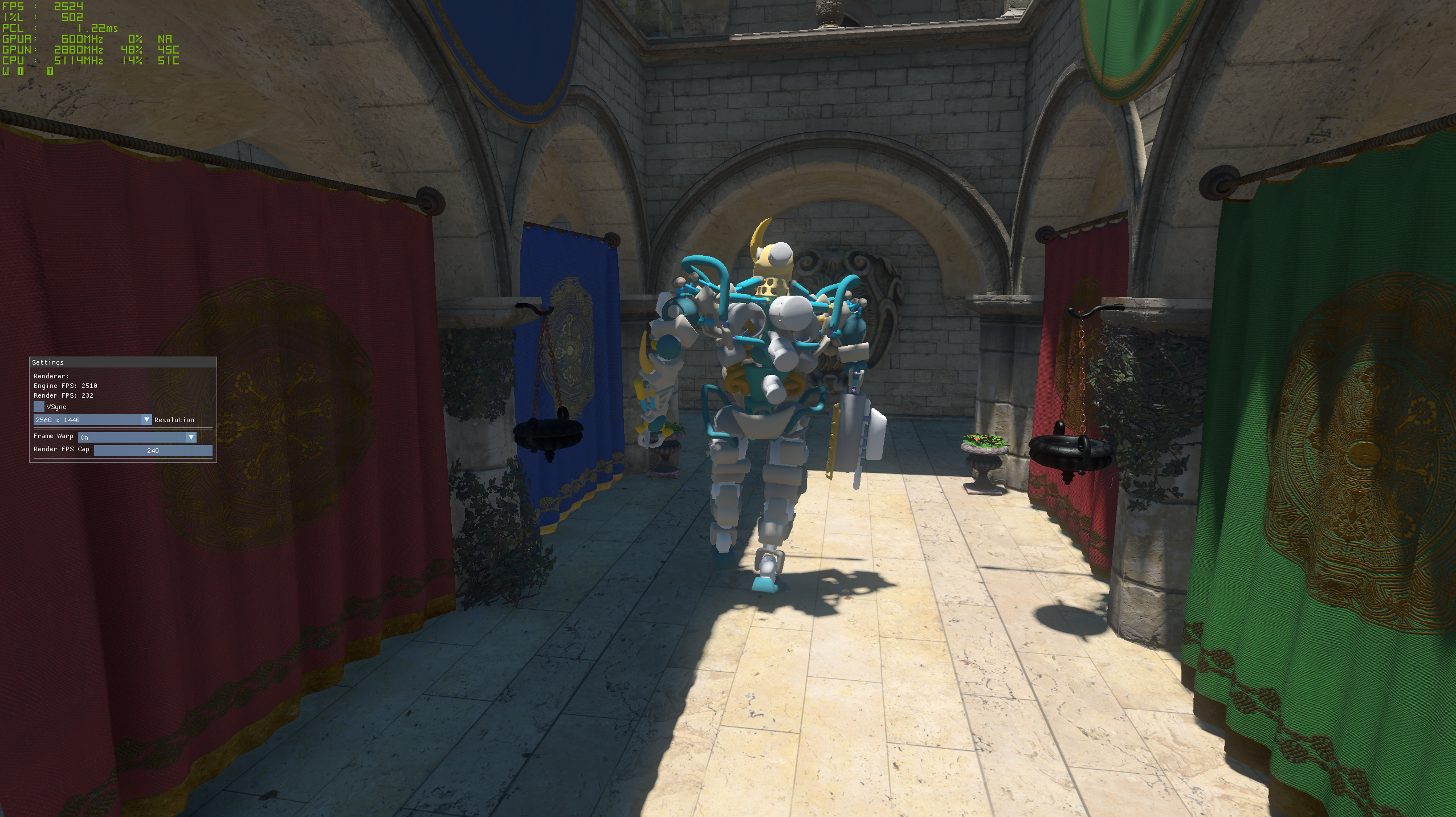Intrepid modder builds Frame Warp demo from Nvidia Reflex 2 binaries — tech remains mysteriously shelved despite greatly reducing latency
Nvidia announced Reflex 2 with Frame Warp back at CES, but the tech still hasn't arrived in shipping games.

Nvidia's Reflex 2 latency reduction tech, introduced alongside its Blackwell architecture, was meant to introduce spatial reprojection - aka "Frame Warp" - to fast-paced games in order to lessen perceived input lag. It also has promise alongside Blackwell's Multi Frame Generation when it's enabled. MFG comes with a substantial input latency penalty when it's running, and Frame Warp could help mitigate it.
As a very quick refresher, Reflex 2 with Frame Warp uses fresh mouse input data collected while a frame is rendering to predict and reproject the camera position of that frame in progress right before it's sent to the display, a process Nvidia claims will heighten the sense of "connectedness" and responsiveness delivered by the PC.
Weirdly, though, Reflex 2 with Frame Warp hasn't been pushed into broad release even as we near a year after its announcement. All GeForce RTX 50-series cards describe it as "coming soon" in their spec tables, and there hasn't been a peep about the tech being enabled for its headlining integrations at CES: The Finals and Valorant.
The modder PureDark, who works in part on putting upscaling and framegen technologies into games that lack native implementations, recently found that the ARC Raiders Playtest files included DLL files that appeared to be related to Reflex 2's Frame Warp functions. With these files in hand, PureDark created a basic working demo of Frame Warp that you can download from Patreon.
I've downloaded PureDark's demo and can confirm that Frame Warp seems to work as advertised in this admittedly early and possibly incomplete or imperfect state, but it's got some small lingering issues that might explain why it still hasn't been widely released.
On an RTX 5070 Ti, the tech does noticeably improve perceived responsiveness when it's enabled, although it probably works even better on a higher refresh rate monitor than the 160Hz display I currently have available. Even if it's not visually perfect, the responsiveness of the demo is noticeably improved with the tech enabled, and I'd certainly be excited to use it if it was more broadly available.
Using Nvidia's FrameView app, which may not be fully updated to report latency properly with Reflex 2, I also monitored the "PC Latency" figure that it shows in its overlay.
Get Tom's Hardware's best news and in-depth reviews, straight to your inbox.
With Frame Warp off and the demo running at 240 FPS, FrameView reports latency of about 7.8 ms. With Frame Warp on, latency drops into the 1-2 ms range when the demo is pushed to the maximum 240 FPS frame rate it'll allow. That's an incredible and perceptible 81% decrease on my system.
There is some swimminess or distortion at the edges of the screen when Frame Warp is enabled, even on Blackwell hardware. My brief experiments with it suggest that Frame Warp works best at 120 FPS and above, as these artifacts are visible even with the demo running at 90 FPS but become less intrusive above that point.
It's not clear whether these lingering artifacts are an inherent limitation of the tech that remains to be ironed out, or something that developers can or will need to tune as part of their integrations, but it's not invisible.
Despite being pitched as a Blackwell feature, this Frame Warp demo also works on my aging GeForce RTX 2080 Ti, but the image quality artifacts at the edges of the frame are even worse on this older hardware, and they don't become less perceptible even as one raises the frame rate of PureDark's demo.
That experience suggests that the latest-gen Tensor Cores of Blackwell cards may be best suited to delivering an optimal experience with the technology enabled, even if it is possible to run this neural network model on older cards with Tensor Cores.
I again have to caution that this is an early look at Reflex 2 and Frame Warp, but PureDark's demo of the tech suggests that it offers exciting and perceptible reductions in input lag when it's enabled. We're not sure what's holding Nvidia and its software partners back from introducing it, but we hope it makes its way into shipping games sooner rather than later.

Follow Tom's Hardware on Google News, or add us as a preferred source, to get our latest news, analysis, & reviews in your feeds.

As the Senior Analyst, Graphics at Tom's Hardware, Jeff Kampman covers everything to do with GPUs, gaming performance, and more. From integrated graphics processors to discrete graphics cards to the hyperscale installations powering our AI future, if it's got a GPU in it, Jeff is on it.